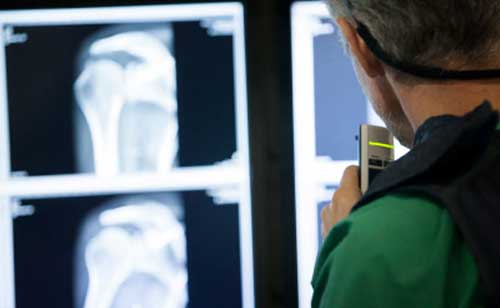In 2013, American technology magnate Michael Dell said that “mobile will figure out health care … before health care figures out mobile.” Initially, he was right, but during the past year the healthcare industry has started to figure it out. More than 15 years after people around the world started using email and text messaging to communicate with their families, friends, colleagues and clients, health care servicesfinally are being transformed by digital and mobile technology.
Interestingly, a lot of the innovation is occurring in emerging markets and not just in the United States, Europe and Japan, where in the past two decades hundreds of billions of dollars have been invested in health care information technology systems that may soon be obsolete. Having grown up in Berlin, I remember well how the telecommunications companies in the former Eastern bloc countries “leapfrogged” after the fall of the Berlin Wall in 1989 and started installing mobile phone and fiber networks rather than sinking billions of dollars into soon-to-be-outdated copper telephone lines. The same pattern has begun to play out in the health care sector worldwide, although it still has a long way to go.
You need look no further than the massive global cyberattacks in May. In the span of just three days, so-called ransomware infected more than 200,000 computer systems in at least 150 countries, encrypting their data so that rightful users no longer had access. The hackers then demanded a ransom payment from the victims using Bitcoin or other hard- to-trace Internet payment systems, before providing the codes to decrypt the data again. Hospitals in Britain’s National Health Service were disproportionally affected, with some operating rooms turning away patients and ambulances being diverted across the country. Nurses had to revert to paper charts to track their patients’ progress and physicians had to handwrite paper prescriptions so pharmacies could fill them. Media reports suggested this was due to many of the nation’s hospitals and clinics still running outdated Microsoft Windows operating systems that can no longer be patched to bring them into compliance with the latest information security standards. In many cases, it will be more cost-effective to replace these aging computer systems entirely and implement new software solutions that take advantage of today’s mobile computing standards, giving patients and their doctors seamless and secure access in the palms of their hands.
Start-up technology players, as well as more established health care providers in countries such as Singapore, Indonesia, China and India, are responding to these developments and investing in digital services and mobile apps at a rapid pace. Venture capital firms and other investors have seen a significant increase in capital provided to start-up companies in the field. In addition, many large insurance companies and even local governments have begun to be supportive of this trend, given the lower costs of services that are being provided digitally and using patients’ mobile phones, which are in effect small supercomputers.
However, an overwhelming number of hospitals, doctor’s offices and even health insurance companies have not yet begun to adapt, and some in fact seem convinced that it is not necessary to innovate or adopt new technologies that could improve the servicesbeing offered to their patients or policyholders. This is not just a problem in Britain; it is a worldwide phenomenon. Change is always hard.
Since I have lived in the United States for the past 25 years, two examples from different industries come to mind. Each should be a cautionary tale for those in the healthcare industry who are reluctant to adapt and respond effectively to the world changing around them.
The first is the home video rental giant Blockbuster, which at its peak in 2004 operated 9,000 stores across the United States with approximately 60,000 employees. The company enjoyed a near monopoly on the American video rental market, with millions of customers flooding their stores each weekend to stock up on the latest Hollywood productions and classic movies. Their stores were in prime locations on almost every street corner. Who would ever be able to compete with them? Blockbuster’s management did not see California-based Netflix as a threat. It was just a small Internet company that did not really understand Blockbuster’s business and did not have any relationships in Hollywood.
Even when the entire movie industry’s business model was called into question by new Internet-streaming technology that allowed customers to access any movie at any time from the comfort of their homes or mobile devices, Blockbuster responded by merely remodeling its stores, fine-tuning its advertising strategy and trying to improve customer service. In 2010, Blockbuster went bankrupt.
The number of photos taken each year worldwide tripled between 2010 and 2015, and now stands at approximately 1.3 trillion pictures a year.
The second example is Kodak. The American company, founded in upstate New York in 1888, held a dominant position in photographic film for most of the 20th century. Every person with a camera used Kodak film at one point, whether they were professionals or weekend hobby photographers. The company enjoyed the leading market position on a global scale, with only one meaningful competitor in Japan’s Fujifilm. What many people do not know is that Kodak actually developed the first digital camera in 1975. However, the company decided not to invest further in the technology at that time since it feared that digital cameras would threaten its near-monopoly position in the global film business. By the time other companies such as Sony started to market digital cameras it was already too late. Kodak’s business was on a downward trajectory. Even before consumers started to regularly use their mobile phones to take pictures, Kodak’s business model seemed doomed. Ironically, the number of photos taken each year worldwide tripled between 2010 and 2015, and now stands at approximately 1.3 trillion pictures a year. Kodak filed for bankruptcy in January of 2012.
The global health care industry is significantly larger than the video rental or photographic film industries ever were, by several orders of magnitude. It behaves more like a giant supertanker in the ocean: it takes a lot of time and energy to turn it around. In the United States, for example, $1.7 trillion is spent on health care annually, and there are more than 784,000 health care companies (including hospitals, clinics and doctor’s offices). In each of the most developed economies around the world, the health care sector is one of the largest. It is also a different type of industry. People need its services to stay alive. That is quite different from wanting to watch a movie or take a photo. Most people do not have a choice about whether to “consume” health care services. They need to go see a doctor or they need to have surgery at a hospital. Further, competition is severely limited because most individuals seek health care near where they live and there often are not that many choices. This has enabled the industry to be slow to adapt to technological change or, at least, to not suffer the consequences right away.
Things are changing, however. The cost of digital technology has continuedto drop significantly and much can now be achieved without spending millions of dollars on expensive and complicated information systems. Both the speed and reliability of telecommunications and mobile phone networks have continued to improve, while the cost to access such networks has continued to decrease. Even five years ago it did not seem realistic for a patient to schedule a videoconference with a physician using his or her smartphone, just so that the physician could take a close look at his or her postsurgical scar. It was much more likely that the patient would endure sitting in traffic for two hours, then spend an hour in a waiting room before spending 10 minutes with the physician. Not a very good use of anyone’s time.
Today, expert health care can literally be at your fingertips, as demonstrated by innovative companies such as RingMD. The company enables anyone with its smartphone app to connect with a doctor, a mental health expert or a wellness practitioner through a video or phone consultation. The Singapore-based start-up company now offers services in more than 30 countries. Dokter Gratis, based in Indonesia, provides a similar service. These are just two examples among literally hundreds in the region. There are popular consumer health portals with large amounts of valuable health information such as Alodokter (Indonesia- based) and Singapore’s DocDoc, which also provides a useful physician appointment booking service. There are health e-commerce platforms such as Indonesia’s ApotikAntar and ProSehat, which have become true online marketplaces to access prescription drugs as well as over-the-counter medicines and vitamin or health supplements, in partnership with local, authorized pharmacies. Medical practice and clinic management solution providers such as Singapore’s Klinify have made it easier to manage patients’ medical records electronically and make them portable across different platforms. Medical data aggregation platforms such as MyDoc (also based in Singapore) have successfully partnered with insurers, governments, corporations and health care providers to streamline their operations and provide enhanced services.
Students today should not be studying to become radiologists because X-rays, CT scans and other medical imaging will soon only be analyzed by artificially intelligent computer systems rather than being “read” by human radiologists who cannot possibly work 24 hours a day.
In the United States, IBM’s “Watson” supercomputer, named after the company’s first chief executive officer, Thomas J Watson, went from competing (and beating the human competition) on a famous television game show in 2011 to taking the radiology board exams in February of this year. The CEO of a large American hospital told me recently that students today should not be studying to become radiologists because X-rays, CT scans and other medical imaging will soon only be analyzed by artificially intelligent computer systems rather than being “read” by human radiologists who cannot possibly work 24 hours a day and who also need vacations. The same executive shared with me that his hospital has conducted more than 25,000 “telehealth visits” and now regularly provides video access to its doctors for patients and their families.
When I asked him about the cost of such services, he answered that it was actually less expensive to provide these services digitally than the old-fashioned way, and in some cases much less expensive and with higher patient satisfaction. Higher patient satisfaction at a lower cost is a combination that is hard to beat.
In 1966, Dr Martin Luther King said at an annual meeting of the Medical Committee for Human Rights in Chicago: “Of all the forms of inequality, injustice in health care is the most shocking and inhumane.” He was talking about the fact that not all Americans had access to the same level of quality health care – a fact that sadly is still a reality more than 50 years later. Even after all of the efforts undertaken President Barack Obama, parts of America have many excellent hospitals and physicians, with strong competition keeping services reasonably priced. There are other areas in the United States, however, where there may only be one poorly managed local hospital nearby that abuses its monopoly by providing inferior services at an inflated price. Unfortunately in America, in too many cases a patient’s postal code determines the quality of health care they receive. Even in one of the most advanced countries in the world, that is the sad reality.
A population without access to quality health care is less productive than one with access.
In India and the Asia-Pacific region, there are many areas that do not even have postal codes. And there are many areas that do not have quality health care services available to the population. This represents a serious challenge to government leaders and policy makers from New Delhi to Jakarta, and from Manila to Beijing. Leaving aside the personal, human toll on many families, a population without access to quality health care is less productive than one with access. It impacts every single sector of the economy, from agriculture and the timber trade to industrial production and retail shopkeepers. If we can incorporate the many advances in medical technology into the patient-physician experience it will result in healthier outcomes. If an employee does not have to miss a day of work to sit in traffic and wait for hours to see a doctor, this has economic benefits and makes companies more productive. If millions of employees are healthier and do not have to miss a day of work, it benefits an entire economy.
After many years of false promises, after many disappointments watching even leading countries struggle with upgrading their health care systems for the 21st century, we are finally witnessing how digital technology is transforming the health care experience for millions – and soon billions – of people around the world. And like with many such global trends, they are driven locally by hundreds and even thousands of entrepreneurs and visionaries who have been investing their time, talent and treasure. They are leveraging technological change in ways that are very meaningful to everyone. To quote Charles Darwin: “It is not the strongest of the species that survives, nor the most intelligent, but the one most responsive to change.”
Michael Marquardt is a globally respected leader, entrepreneur, and sought-after advisor who enables companies to conquer the formidable bureaucratic, social and political challenges of opening, acquiring, and growing businesses abroad. His management and collaborative skills have added considerable value in many mergers and acquisitions. Clients have looked to him to identify and cultivate talent for senior recruitment needs and to provide decisive market intelligence.
Follow Michael on Twitter @MarquardtGlobal.





